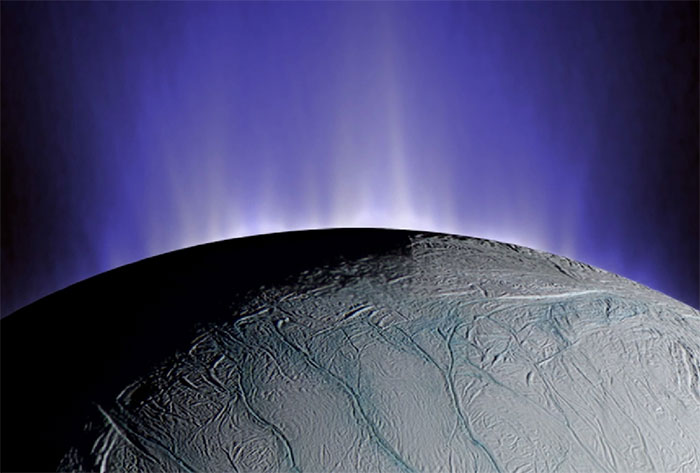Traces of life in an unexpected place in the middle of the solar system
Scientists have just discovered a place that may contain evidence of alien life that can easily be captured by human spacecraft.
According to SciTech Daily, a study led by the University of Washington (USA) and Freie Universität Berlin (Germany) has shown that ice particles sprayed from Europa or Enceladus may contain evidence of alien life . NASA has been searching for a long time.
Europa is a moon of Jupiter, Enceladus is a moon of Saturn.

Material ejected from the surface of Enceladus may contain traces of life - (Graphic image: NASA).
Beneath the icy shells of these icy moons lie underground oceans , where planetary scientists believe life may lurk.
However, finding life beneath this ice shell is a big challenge. NASA plans to launch the Europa Clipper spacecraft to Europa in October 2024 and is testing a robotic snake for Enceladus.
The new discovery shows that Europa Clipper may have a great chance of success with ice particles.
According to research recently published in the scientific journal Science Advances, hydrothermal activity on the underground ocean floor of these two moons as well as cracks in the ice shell can create enough momentum to push material along the stream. Water sprayed out into space.
This stream of material is highly likely to contain enough living cells for mass spectrometers - which are equipped on many NASA spacecraft and even Europa Clipper - to identify.
Researchers have shown this through simulation models, simulating how icy particles escape the oceans of Europa and Enceladus, fly at a speed of 4-6 km/s in space and collide with each other. observation devices.
Mass spectrometers have been successful in identifying vital signs, especially with a powerful mass spectrometer like the SUrface Dust Analyzer on the Europa Clipper, which is capable of detecting a single cellular material mixed in hundreds of thousands of ice particles.
Even scientists believe that even a living bacteria has a chance of being discovered.
It would be a Sphingopyxis alaskensis or its relative, or a similar sized species. It is a microscopic bacteria found in the US state of Alaska, whose entire body can fit into a grain of ice.
This discovery could be a guide for NASA and other space agencies to program their spacecraft in upcoming life-hunting missions.
- NASA found the ideal place for life in the Solar System
- Discover the oldest solar system outside the solar system
- Life has spread throughout the solar system
- NASA announced a place that could exist in the solar system
- Surprise with a strange life on the new solar system discovered
- The fake life in the solar system has 2 suns?
- The new model quickly identifies life outside the solar system
- The largest solar system outside the solar system revolves around two stars
- Beautiful photo from the Solar System
- The Solar System's water was born before the Sun.
- Our solar system in the galaxy is rare
- Explore the atmospheric atmospheres of the solar system
 Van Allen's belt and evidence that the Apollo 11 mission to the Moon was myth
Van Allen's belt and evidence that the Apollo 11 mission to the Moon was myth The levels of civilization in the universe (Kardashev scale)
The levels of civilization in the universe (Kardashev scale) Today Mars, the sun and the Earth are aligned
Today Mars, the sun and the Earth are aligned The Amazon owner announced a secret plan to build a space base for thousands of people
The Amazon owner announced a secret plan to build a space base for thousands of people